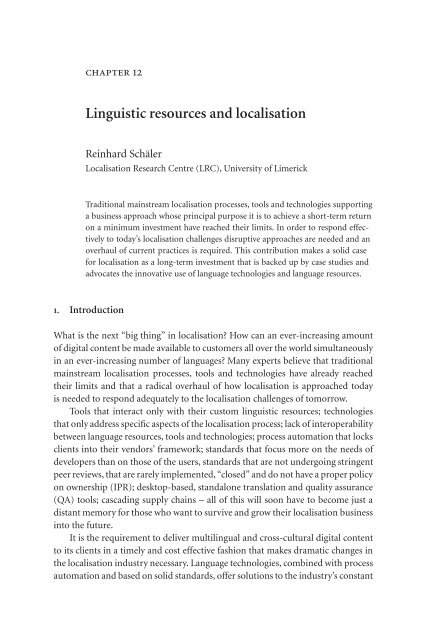Topics in Language Resources for Translation ... - ymerleksi - home
Topics in Language Resources for Translation ... - ymerleksi - home
Topics in Language Resources for Translation ... - ymerleksi - home
- No tags were found...
You also want an ePaper? Increase the reach of your titles
YUMPU automatically turns print PDFs into web optimized ePapers that Google loves.
chapter 12L<strong>in</strong>guistic resources and localisationRe<strong>in</strong>hard SchälerLocalisation Research Centre (LRC), University of LimerickTraditional ma<strong>in</strong>stream localisation processes, tools and technologies support<strong>in</strong>ga bus<strong>in</strong>ess approach whose pr<strong>in</strong>cipal purpose it is to achieve a short-term returnon a m<strong>in</strong>imum <strong>in</strong>vestment have reached their limits. In order to respond effectivelyto today’s localisation challenges disruptive approaches are needed and anoverhaul of current practices is required. This contribution makes a solid case<strong>for</strong> localisation as a long-term <strong>in</strong>vestment that is backed up by case studies andadvocates the <strong>in</strong>novative use of language technologies and language resources.1. IntroductionWhat is the next “big th<strong>in</strong>g” <strong>in</strong> localisation? How can an ever-<strong>in</strong>creas<strong>in</strong>g amountof digital content be made available to customers all over the world simultaneously<strong>in</strong> an ever-<strong>in</strong>creas<strong>in</strong>g number of languages? Many experts believe that traditionalma<strong>in</strong>stream localisation processes, tools and technologies have already reachedtheir limits and that a radical overhaul of how localisation is approached todayis needed to respond adequately to the localisation challenges of tomorrow.Tools that <strong>in</strong>teract only with their custom l<strong>in</strong>guistic resources; technologiesthat only address specific aspects of the localisation process; lack of <strong>in</strong>teroperabilitybetween language resources, tools and technologies; process automation that locksclients <strong>in</strong>to their vendors’ framework; standards that focus more on the needs ofdevelopers than on those of the users, standards that are not undergo<strong>in</strong>g str<strong>in</strong>gentpeer reviews, that are rarely implemented, “closed” and do not have a proper policyon ownership (IPR); desktop-based, standalone translation and quality assurance(QA) tools; cascad<strong>in</strong>g supply cha<strong>in</strong>s – all of this will soon have to become just adistant memory <strong>for</strong> those who want to survive and grow their localisation bus<strong>in</strong>ess<strong>in</strong>to the future.It is the requirement to deliver multil<strong>in</strong>gual and cross-cultural digital contentto its clients <strong>in</strong> a timely and cost effective fashion that makes dramatic changes <strong>in</strong>the localisation <strong>in</strong>dustry necessary. <strong>Language</strong> technologies, comb<strong>in</strong>ed with processautomation and based on solid standards, offer solutions to the <strong>in</strong>dustry’s constant
















